Farmington is in a sort of wrapped bowl of the Wasatch Mountains which traps clouds – the bane of bird photographers. Much the same thing happens to morning fog, especially during winter. Collectively I call the phenomenon the “Farmington Curse” and that curse, in the form of fog, was much in evidence two mornings ago when I spent some time with a Long-tailed Weasel. Apologies for the image quality of the first three shots. In an attempt to mitigate some of the effects of the fog I had to do some fairly heavy-handed processing and it shows.
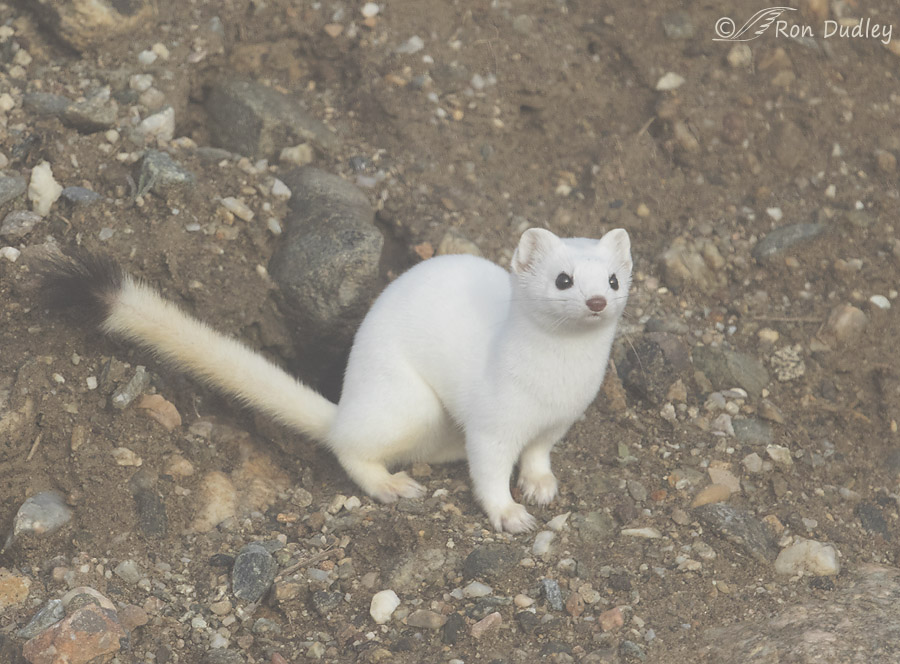
1/800, f/8, ISO 800, Canon 7D Mark 2, Canon EF500mm f/4L IS II USM +1.4 tc, not baited, set up or called in
This time of year of course the weasel was in its white winter coat – they’re pure white except for their pitch black eyes and the black-tipped tail. Based on its size I’d guess that this was a (larger) male. He was hunting among some boulders near the north end of Farmington WMA. Typical of the species his movements were quick and sinewy as he loped around the rocks looking for voles and mice.
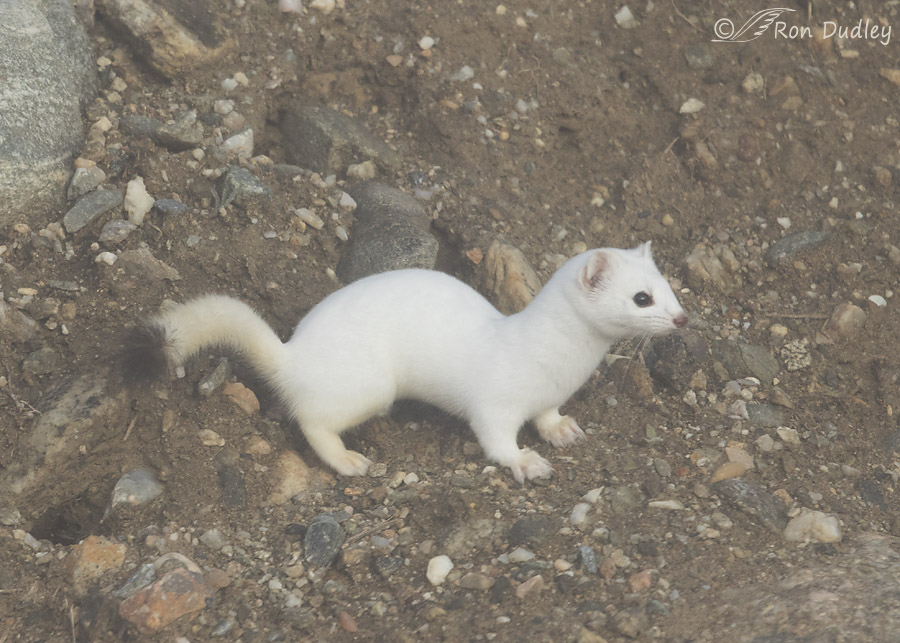
1/800, f/8, ISO 800, Canon 7D Mark 2, Canon EF500mm f/4L IS II USM +1.4 tc, not baited, set up or called in
Almost certainly the burrow entrance you see at lower left belongs to a vole (who may be inside trembling in fear…).
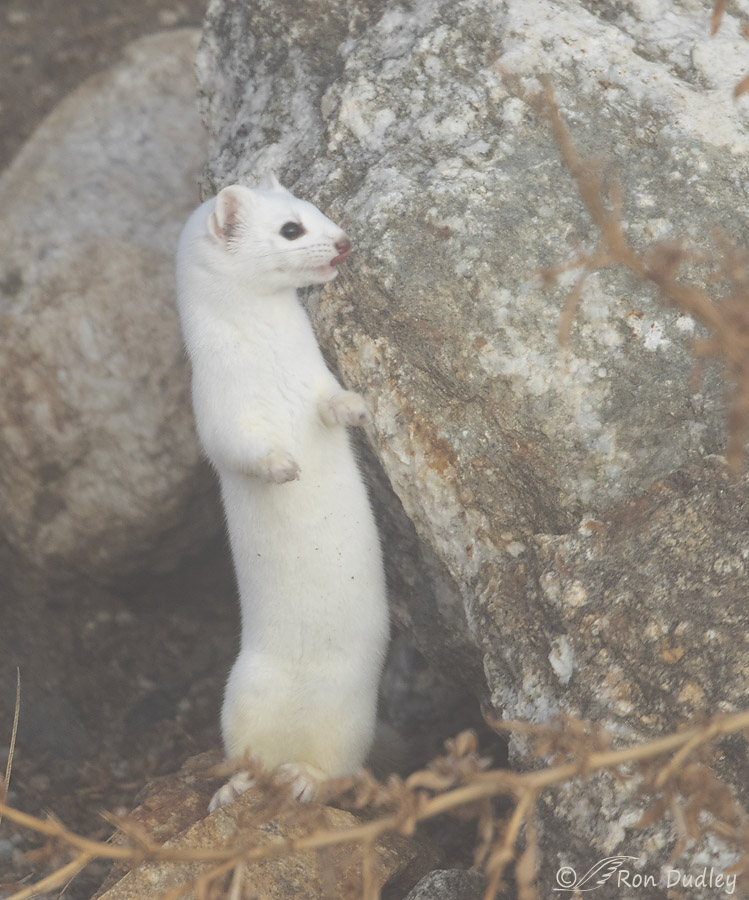
1/640, f/8, ISO 800, Canon 7D Mark 2, Canon EF500mm f/4L IS II USM +1.4 tc, not baited, set up or called in
The fog often made it difficult to get a sharp focus lock on him and this shot is soft but I included it because I caught him as he was licking his nose with his tongue.
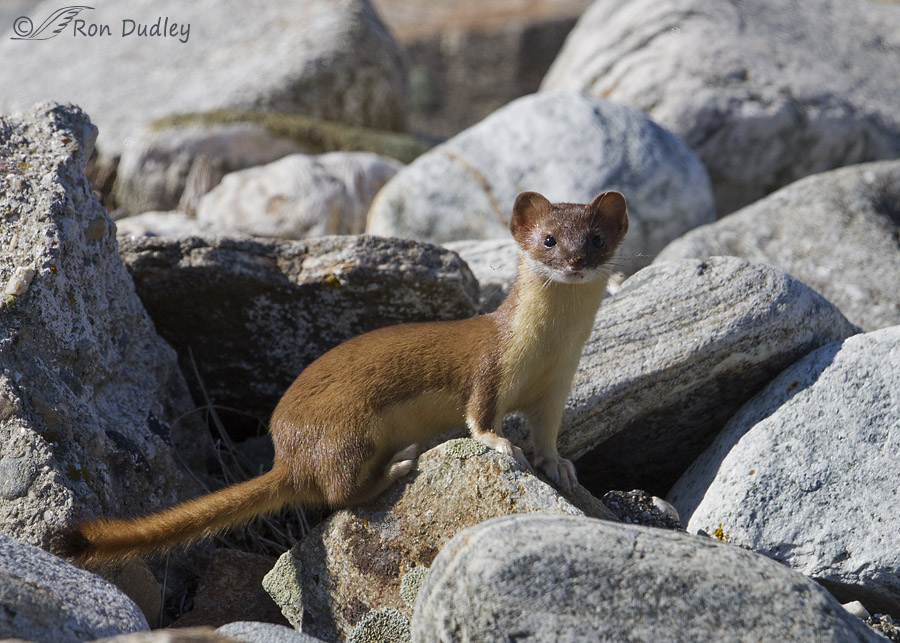
1/1600, f/7.1, ISO 500, Canon 7D Mark 2, Canon EF500mm f/4L IS USM +1.4 tc, not baited, set up or called in
To the uninitiated it’s difficult to believe that this critter is also a Long-tailed Weasel. I photographed this one on August 28 of this year within about 100 yards of where I found the white one, above (perhaps they’re the same weasel?). In colder latitudes weasels undergo a seasonal color change for obvious camouflage reasons. Southern weasels do not change color.
We know that the color change is genetically controlled rather than triggered by temperature change because when southern weasels are transplanted to the snowy north they still do not turn white in winter. And when northern weasels are moved to a location in the warm south they still turn white in winter.
The trigger for the genetically controlled transformation is length of day so when it’s unseasonably warm in winter (as it has been around here lately) white weasels stand out like a sore thumb when there’s no snow. That makes them unusually vulnerable to predators (and to being spotted by photographers like me).
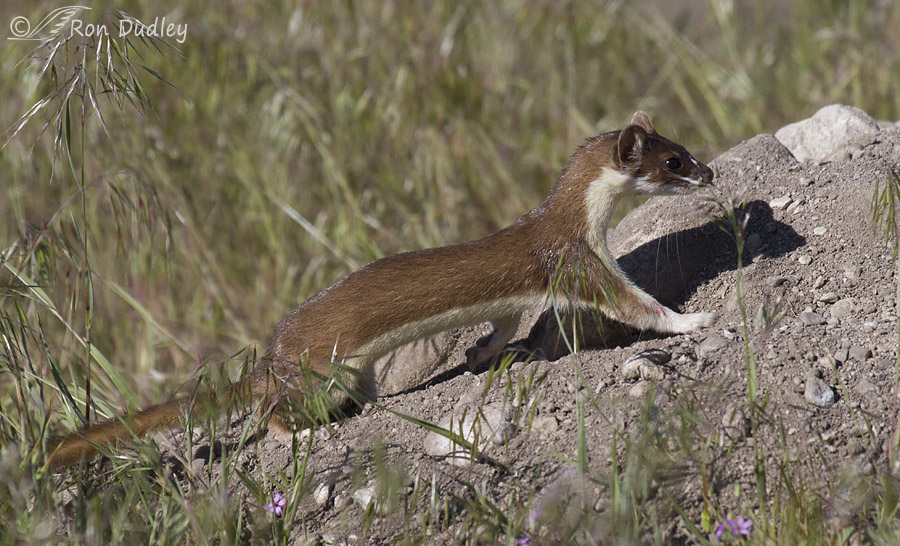
1/2500, f/8, ISO 500, Canon 7D Mark 2, Canon 100-400 @400mm, not baited, set up or called in
I photographed this weasel on a badger mound on Antelope Island this past May. This view gives a good look at that long, lithe body that is designed to go after small rodents in confined spaces. It’s interesting that Long-tailed Weasels in the southwestern states often have white facial markings as this one does but this is the only Utah individual I can recall seeing that had those markings.
The only part of their pelage that doesn’t turn white in winter is their black-tipped tail. Birds of prey (especially hawks and owls) are predators of weasels and in experiments, hawks presented with a stuffed weasel that lacks the black on the tail had no difficulty identifying it as vulnerable prey and attacked the weasel’s head. However, if the stuffed weasel did have a black-tipped tail the hawks often hesitated and then attacked the tail. That would give the fierce little weasel a fighting chance, perhaps enough of a chance to have that black-tipped tail selected for over many generations of evolution.
Ron


Hi, Ron, what a wonderful series, both the foggy and the clear! I rarely see weasels (and never in their winter coats), so I appreciate these guys portrayed any way, anyhow. I know you’ve talked about post processing here previously. So, a pragmatic question about your particular method: Do you ever employ Photoshop levels adjustments on foggy shots, for example, to cut through the haze? Or do you prefer to leave them as shot, for that particular effect and for depicting reality as you saw it?
Ingrid, “levels adjustment” is exactly what I did here to try to cut through the fog. That said, more often than not I prefer to present the image as it looked to me, without such adjustments. In my experience many foggy images don’t have much appeal so I typically delete those shots but sometimes the foggy atmosphere can really add to the mood of the image. With these weasel images I didn’t think the fog added anything positive and I wanted to feature the critter itself as much as I could so I used “levels”.
Thanks. And I totally understand trying to capture what you experienced. Of course, I also realize there’s no way our cameras, amazing as they are, can fully replicate what our eyes see. I am probably in the minority (as with most things) but I love foggy, atmospheric shots. Now it makes me wonder what you might have deleted, Ron! I hope someday to see a weasel like this in his or her winter PJs. They are so beautiful and I need to spend a winter somewhere where it’s actually winter and where animals turn white in response.
I hope someday to see a weasel like this in his or her winter PJs. They are so beautiful and I need to spend a winter somewhere where it’s actually winter and where animals turn white in response.
That such a predator can be so cute always surprises me. I love the pairing of white winter coat shots with non-winter coat shots; much more interesting than me putting on my winter jacket!
It visually surprises me too, Kathleen.
How fascinating that a skilled predator is preyed upon. And how amazing that the tip of the tail may give it a fighting chance. Better to lose a tail than a head…
Elephant’s Child, Interesting that sources list birds of prey as their most common predators but the only weasels I’ve seen killed by predators were killed by badgers or other weasels…
Really interesting information! I only recently discovered (thanks to another of your posts!) that Long-tailed Weasels are found throughout Florida. I’m gonna hafta start paying better attention.
Wally, Around here you have to look for them differently (different places) than you do most birds. The more we look the more we find…
Fun photos, especially the one where the weasel is licking its nose.
Susan, I almost didn’t include that one due to its softness. Still fun though…
Great shots Ron, even with the fog. Great series and good lesson!!
Thank you, Dick.
That’s really interesting, Ron. Thank you. Fascinating creatures and their coats, wow, beautiful. Over here I don’t think I’ve ever seen a weasel but we have lots of deer though and I do know that the deer lick their noses to help them smell. It does look funny while watching them.
I also wondered if that was why the weasel did it, Dianne, and he did it more than once.
Great shot of him standing, licking his nose! Nervous habit? Anticipating his next meal? They are cute — even if cunning killers. Interesting about Hawks’ response to the black-tipped tail, it’s not just a fashion statement, apparently! Thanks for the pics and information, Ron.
Chris, I caught him licking his nose (or at least with his tongue out) twice, in two different poses, but the other shot was even softer than this one.
“Not just a fashion statement, apparently” – nope, don’t think so. But they certainly are handsome devils…
Thanks, Ron. There’s something about photos of weasels that make me so happy – probably because I’m not a chicken!
I love to unexpectedly laugh heartily, Alison and your comment made me do just that. Thanks for that!
Thanks Ron. I had no idea weasels turned white in winter. They are cute little guys. Thanks for giving us this info. I have never seen a weasel live so I appreciate you sharing the photos and the story behind them.i have learned so much from your blogs. Thank you.
I just had to share this. The day after you shared your family history, I was looking for a special gift for my friend. I finally found the perfect gift and believe it or not it is being hand made by a gentleman in Dudley England. Small world.
Debbie, Two weasel species in North America, the Long-tailed and the Short-tailed Weasel, both turn white during winter in their northern range.
Thanks for the “Dudley” feedback. Small world is right. I’d love to make it to Dudley castle one day but haven’t been able to figure out how to do it easily without flying…
Ron, that’s what repositioning cruises are for. That would work for one direction. The other one? Good luck!
Amazing shots Ron! Thanks for sharing!
Charlotte
Thank you, Charlotte.
Interesting read the genetics.
Thanks, Arwen.
Interesting info re: color changes, genetic programming…until now, I thought it was triggered by seaonal changes in daylight. WRONG!!! Hard to believe something so cute is a master killer (much like that other cute killer, the kestrel)…
I’ve watched them kill voles a time or two, Patty. They’re so fluid and effortless when they do it. Masters at their craft…